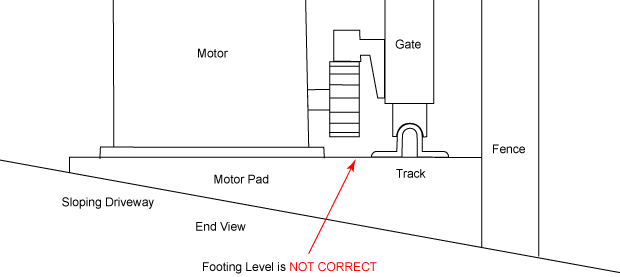
How To Install Footings for Sliding and Telescopic Driveway Gates
Want to install an automatic sliding driveway gate but don't know where to start? well like any good project you need a good solid footing, one that's in the right place, the right size, the right strength and on the right slope.
Check out the following video on how to install footings for sliding gates or read below.
If you're in Australia and would like to buy hardware for sliding gates, motors or full gate check out these links:
Concrete Footing for Sliding Gates
Sliding Driveway gates roll on a metal track that needs a good solid footing. If you have a concrete driveway then you're halfway there, but there needs to be somewhere for the gate to open too and a pad for the motor. If there is enough ground off to the side of the driveway that is relatively level then a concrete footing will do. Other situations will be covered later.
You will need to dig, at least 100mm (4") deep or more until you into firm ground. You're only supporting the weight of a gate, not a house, so it doesn't need to be too substantial.
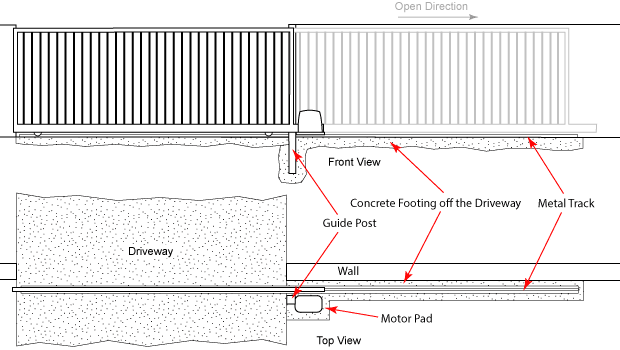
If you need a guide post it's best to dig this into the ground too at the same time as the footing. The motor pad will need to move over a bit to allow room for a guide post.
READ MORE About Guides and Stops for Sliding Gates
Concrete can easily be mixed on site with a concrete mixer because normally only about 1/8 of a cubic meter (or 1/6 cubic yard) is needed, which is less than the minimum amount a concrete truck will deliver.
If the motor is to have power cabling hard wired then a conduit should be set into the middle of the motor pad. If you prefer a power outlet this can be installed on the guide post, which is neater if the cable is run inside the post or if there is no guide post it can be on a small post of its own. A power outlet should not be fitted to the fence or wall as this is on the wrong side of the gate, how would it plug in?.
Dimensions for Concrete Footings
All dimensions given assuming a 50mm (2") thick gate frame with nothing fitted to the front of the frame or a 40mm (1 5/8) thick frame with up to 16mm (10/16") material fitted to the front of the frame, if the gate is thicker then extra clearance would need to be added between the fence and the gate to allow for the extra. If the motor is a different size then the dimensions for the motor pad need to be adjusted accordingly too eg. if the motor is 400mm (16") wide then the motor pad should be at least 500mm (20") wide, make it bigger if not sure.

If the gate has guide rollers or other bracket that goes over the top of the gate a guide post won't be needed.

The length of the footing off the side of the driveway is generally the width of the gate + 400mm (16").
When Driveways Angle Towards the Motor

If your driveway is angled towards the motor and there's no guide post the motor pad needs to be moved along the fence. To get this offset place the motor (or a substitute) with its back at the correct distance behind the fence by 325mm (13") and a corner just touching the edge of the driveway, the motor pad width dimension always starts from the driveway side of the motor. The extension to the bottom rail of the gate will need to be longer too. The amount the gate opens will also need to be more so it fully clears the driveway.

If the driveway angles towards the motor and there is a guide post then this must have its corner hard up against the driveway or the corner of a power point if fitted and the motor hard up against the guide post so the motor pad will be offset be a distance along the fence from the driveway. The extension to the bottom rail of the gate will need to be even longer again.
When Driveways Angle Away from the Motor

If the driveway is angled away from the motor and there's no guide post the motor pad can be closer to the driveway and the extension to the bottom rail of the gate can be less. The gate won't need to open as much to clear the driveway.

If the driveway angles away from the motor and there is a guide post the motor pad will need to be the width of the guide post wider and extension to the bottom rail of the gate this much longer too.
If the Driveway isn't Concrete
If you have a paved driveway and the pavers are not glued to a concrete base, you can either replace a line of paver's with concrete or pull up the paver's, install concrete underneath and glue the paver's to the concrete keeping consistency in the appearance of the driveway.
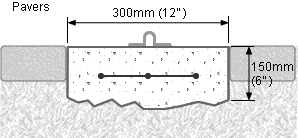

If you have a bitumen or gravel driveway you will need to replace a strip of it with concrete. If the driveway is bitumen the concrete can be coloured black using black oxide so it will match the driveway better.

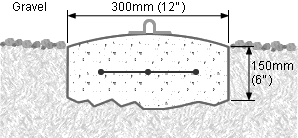
Gravel driveways should be raised in the middle to prevent build up of the gravel on the track.
You will need reinforcing steel in the footing preferably trench mesh not just lengths of rio. Rio can be used if it made into a mesh with short cross pieces tied on with wire. The area of footing off the driveway doesn't really need reinforcing steel because it isn't bearing any weight although can be put in anyway if you want to prevent any cracking of the concrete.
Concrete Footings for Telescopic Sliding Gates
If there isn't enough room off to the side of the driveway for a sliding gate to open then two or three sliding gate panels can be used across a driveway that stack up one behind one another when open, which are commonly called telescopic gates and require much less space to open.
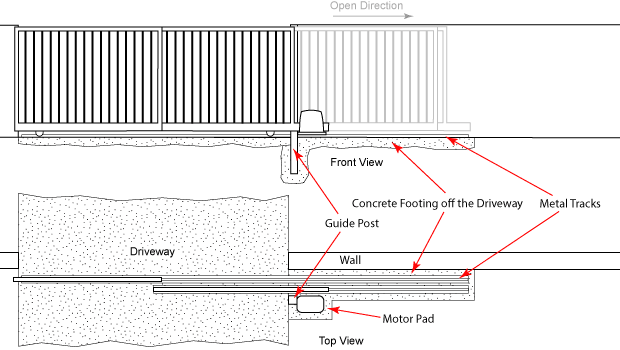
The footing for these needs to be wider to allow for two or three tracks side by side.
Dimensions for Concrete Footings for two panel Telescopic Gates
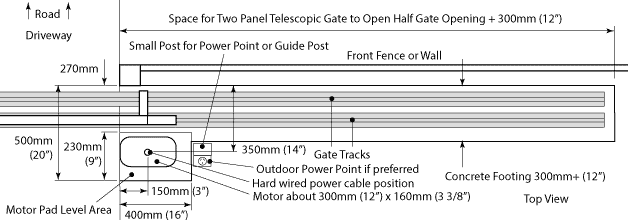
Two panel telescopic gates require two tracks side by side so the footing needs to be wider to allow for this.

If the Driveway is angled towards to motor the gate will need to open further, motor and guide post (if there is one) will need to be moved over too so everything clears the driveway.
Dimensions for Concrete footings for Three Panel Telescopic Gates
Three panel telescopic gates need an even wider footing because they have three tracks side by side.
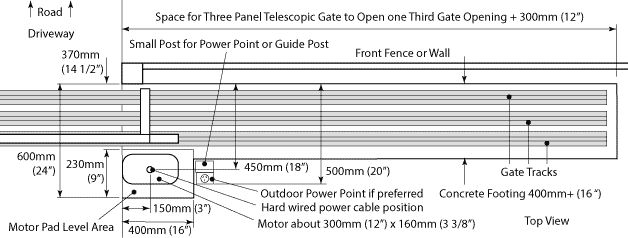
Ground that Slopes Up off the edge of the Driveway
If the ground slopes up from the edge of the driveway it must first be excavated, then have a concrete footing installed and a retaining wall built that rises above the ground to keep the footing clear of any debris. Concrete or hardwood sleepers are ideal for retaining walls.
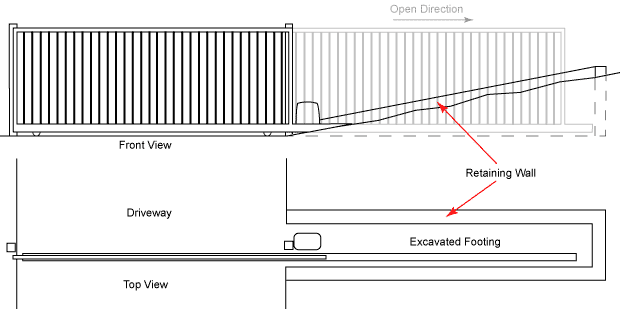
The gate track should be well drained and pad for the gate motor high enough so rain water runs around it.
Ground that Slopes Up off the edge of the Driveway
If the ground slopes up from the edge of the driveway and is steep a telescopic gate maybe more economic to install than a single panel sliding gate because it requires a lot less excavation and retaining.
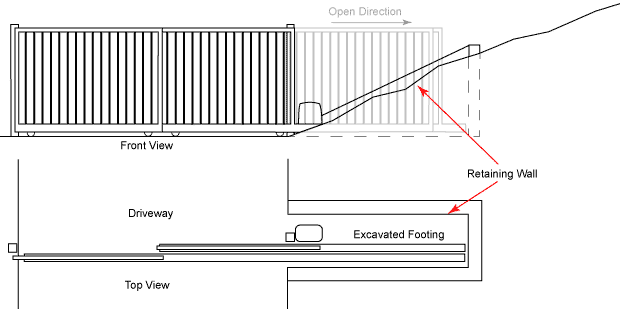
On a steep slope half the excavation means a quarter of the volume of soil that needs to be excavated and retained.
Ground that Slopes Down off the edge of the Driveway
If a ground drops down from the edge of the driveway where the gate is to open then the track may be elevated with a metal frame rather than using a big lump of concrete. This frame should be on the same slope as the driveway. The frame should have support posts every 1m or so concreted into the ground and need only be 100mm wide.
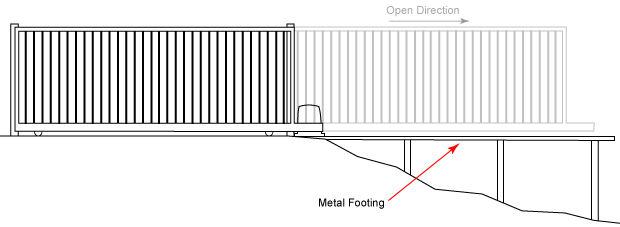
Once again if the slope is steep a telescopic gate may be more economic to install because a lot less frame is required at the the really high part.
Slope Across the Driveway
Footings for driveways that slope across must be straight and on the same slope as the driveway. The pad for the motor should be level and high enough so rain water runs around it.

Slope up the Driveway
If the driveway slopes from the direction of the road the footing must be on the same slope as the driveway
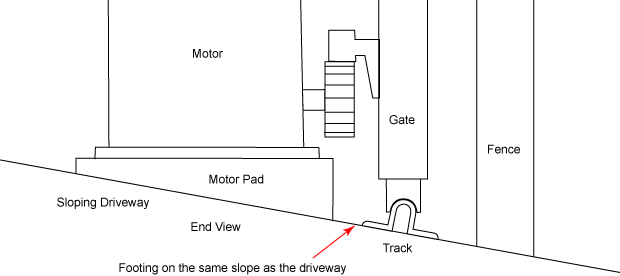
The pad for the motor should be level and high enough so any rain water runs around it and not through the motor.
Footing NOT to be Level if Driveway is not.
The footing for the gate track should not be level if the driveway is sloping, this will not work. The footing may start on the same slope as the drive way and gradually become level over a distance of 1.8 metres (6') or more if need be.
